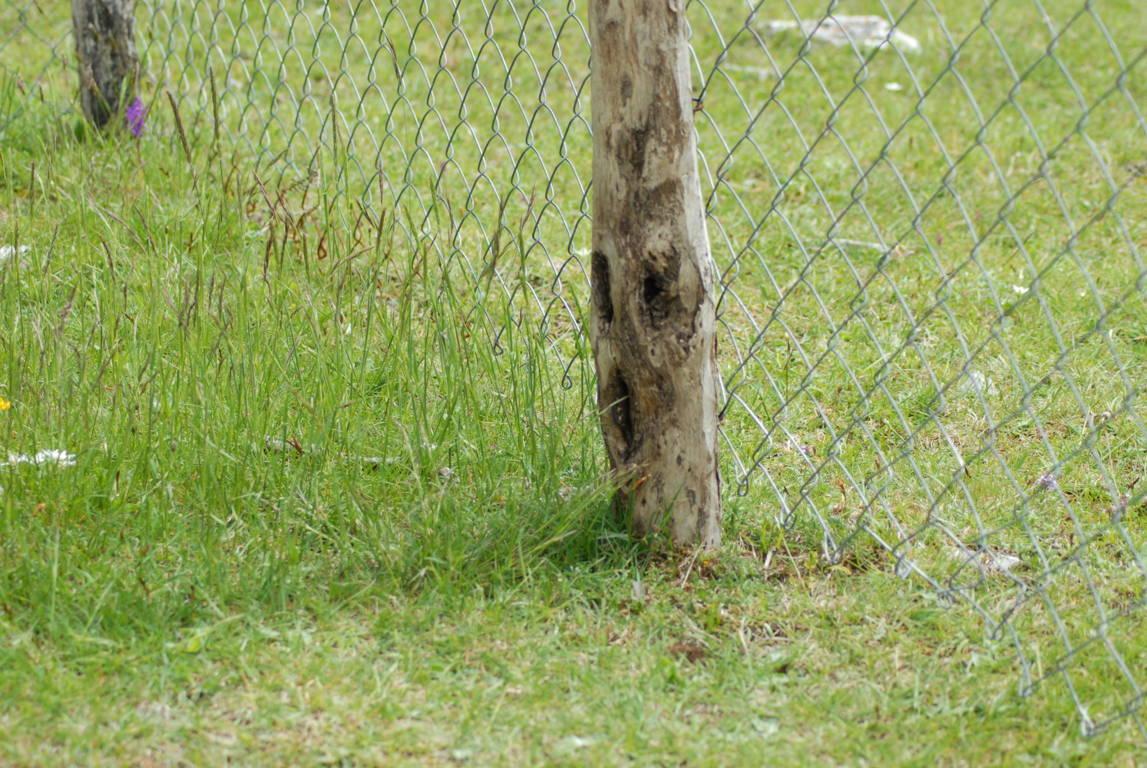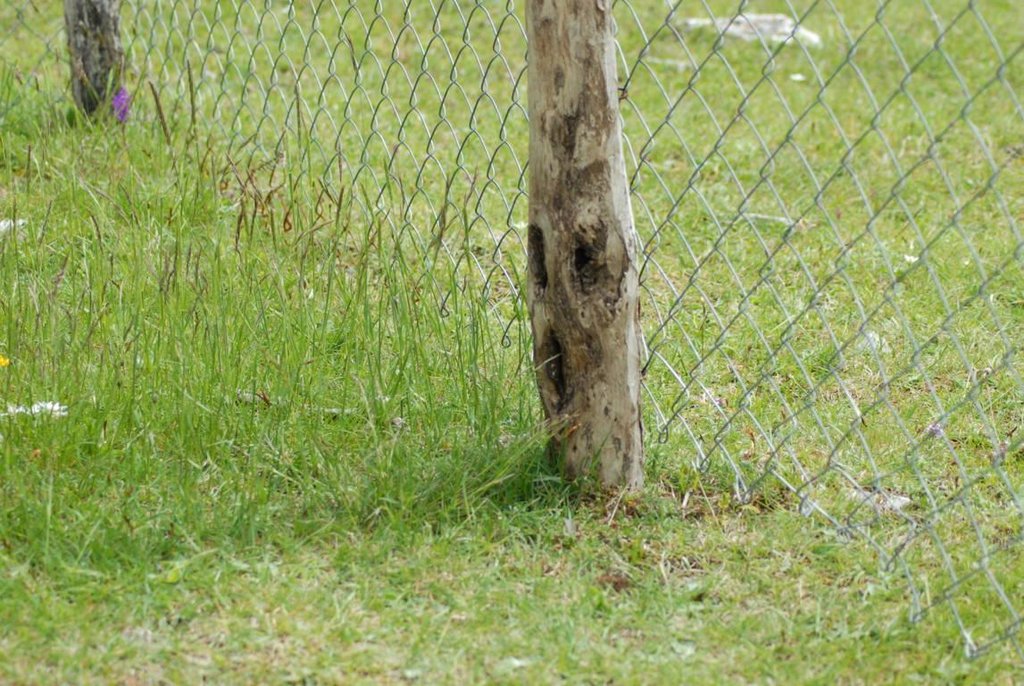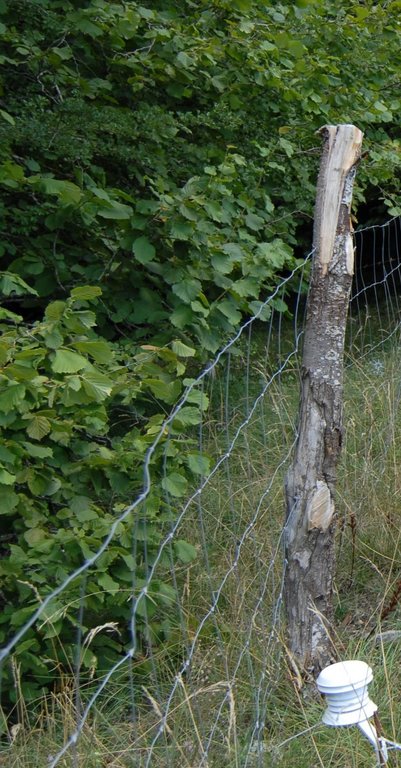Metallic fences to prevent damages to pastures from wild boars [Italy]
- Creation:
- Update:
- Compiler: Velia De Paola
- Editor: –
- Reviewer: Fabian Ottiger
technologies_1608 - Italy
View sections
Expand all Collapse all1. General information
1.2 Contact details of resource persons and institutions involved in the assessment and documentation of the Technology
SLM specialist:
Quaranta Giovanni
University of Basilicata
Via Nazario Sauro, 85, 85100 Potenza, Ita
Italy
Name of project which facilitated the documentation/ evaluation of the Technology (if relevant)
Catastrophic shifts in drylands (EU-CASCADE)Name of the institution(s) which facilitated the documentation/ evaluation of the Technology (if relevant)
University of Basilicata - Italy1.3 Conditions regarding the use of data documented through WOCAT
When were the data compiled (in the field)?
27/06/2014
The compiler and key resource person(s) accept the conditions regarding the use of data documented through WOCAT:
Ja
2. Description of the SLM Technology
2.1 Short description of the Technology
Definition of the Technology:
CONSTRUCTION OF FENCES TO KEEP WILD BOAR OFF PASTURE LAND
2.2 Detailed description of the Technology
Description:
ẗhe regulations implemented by the Pollino national park to protect the wild fauna have led to large numbers of wild boar in the local area. Numbers of wild boar have also increased because of breeding with non-native species (a Hungarian strain) on the part of hunting associations. Numbers have increased so much that currently these animals have even reached rural areas destined for pasture, livestock farming and cultivation. To protect crops and pastures more fences have been built. Typically these fences are constructed out of pales made from local wood and galvanised iron netting.
Purpose of the Technology: Protection of pasture land and cropland
Establishment / maintenance activities and inputs: The construction of fences requires an initial investment in order to buy the wooden pales and iron netting. Generally the pales come from local woods, often from the farm itself, and are felled and prepared by local farmers who also usually construct the fences themselves. The height of the fences ranges from 1m to 1.20
Natural / human environment: Production methods are characterised by a medium level of mechanisation (only the most demanding operations are carried out using mechanical means), the production system is essentially mixed, a small part is destined for personal consumption whilst the bulk of production is destined for local markets. The property is predominantly privately owned but also includes some public land, especially in the case of pasture land. Most farms in the area are livestock farms whilst the agricultural component is destined exclusively for private consumption. The area is partially included in two bordered national parks, i.e. Pollino national park and val d’agri national park. This peculiar situation creates a very natural environment allowing the presence of many wild species.
2.3 Photos of the Technology
2.5 Country/ region/ locations where the Technology has been applied and which are covered by this assessment
Country:
Italy
Region/ State/ Province:
Basilicata
Further specification of location:
CASTELSARACENO
2.6 Date of implementation
If precise year is not known, indicate approximate date:
- 10-50 years ago
2.7 Introduction of the Technology
Specify how the Technology was introduced:
- through land users' innovation
3. Classification of the SLM Technology
3.2 Current land use type(s) where the Technology is applied

Cropland
- Annual cropping

Grazing land
Extensive grazing land:
- Semi-nomadism/ pastoralism
- Ranching
Main animal species and products:
Main animal species ranching: Sheep/Goats/Cow
Comments:
Major land use problems (compiler’s opinion): The wild boar tend to dig into the ground in search of food and, in doing so, leave soil open to processes of erosion and permanently degrade grass cover.
Major land use problems (land users’ perception): Severe damage to grass cover and crops
Semi-nomadism / pastoralism: Shepherds use the area for summer grazing and move downhill in winter
Mixed: (eg agro-pastoralism, silvo-pastoralism): A reduced number of farmers cultivate their field for fodder and pastures
Grazingland comments: Sheep and goats are the most valuable livestock
Type of grazing system comments: Sheep and goats are the most valuable livestock
3.3 Further information about land use
Comments:
Water supply: rainfed, mixed rainfed - irrigated
Number of growing seasons per year:
- 1
Specify:
Longest growing period in days: 120Longest growing period from month to month: march to august
Livestock density (if relevant):
> 100 LU /km2
3.4 SLM group to which the Technology belongs
- Protection of pasture land and cropland from wildlife
3.5 Spread of the Technology
Specify the spread of the Technology:
- evenly spread over an area
If the Technology is evenly spread over an area, indicate approximate area covered:
- 0.1-1 km2
3.6 SLM measures comprising the Technology

structural measures
- S6: Walls, barriers, palisades, fences
Comments:
Main measures: structural measures
3.7 Main types of land degradation addressed by the Technology

soil erosion by water
- Wt: loss of topsoil/ surface erosion

physical soil deterioration
- Pc: compaction

biological degradation
- Bc: reduction of vegetation cover
- Bh: loss of habitats
- Bq: quantity/ biomass decline
- Bs: quality and species composition/ diversity decline
Comments:
Main type of degradation addressed: Wt: loss of topsoil / surface erosion, Bc: reduction of vegetation cover, Bq: quantity / biomass decline, Bs: quality and species composition /diversity decline
Secondary types of degradation addressed: Pc: compaction, Bh: loss of habitats
Main causes of degradation: increase and spreading of wild boars
Secondary causes of degradation: other human induced causes (specify) (Introduction of wild boars by hunting associations), governance / institutional (Excessive protection of the species by the National park)
3.8 Prevention, reduction, or restoration of land degradation
Specify the goal of the Technology with regard to land degradation:
- prevent land degradation
4. Technical specifications, implementation activities, inputs, and costs
4.2 Technical specifications/ explanations of technical drawing
Technical knowledge required for land users: low
Secondary technical functions: improvement of ground cover, increase of biomass (quantity)
Structural measure: FENCES
Spacing between structures (m): 1pale/1.33m
Construction material (wood): Pales in wood
Construction material (other): Iron net (1 meter high)
4.3 General information regarding the calculation of inputs and costs
other/ national currency (specify):
euro
Indicate exchange rate from USD to local currency (if relevant): 1 USD =:
0.74
Indicate average wage cost of hired labour per day:
81.08
4.4 Establishment activities
| Activity | Type of measure | Timing | |
|---|---|---|---|
| 1. | Wood pales and network | Structural | every 20 years |
| 2. | wood pales | Structural | |
| 3. | Iron net | Structural |
4.5 Costs and inputs needed for establishment
| Specify input | Unit | Quantity | Costs per Unit | Total costs per input | % of costs borne by land users | |
|---|---|---|---|---|---|---|
| Labour | Wood pales and network | 1000m | 1.0 | 5000.0 | 5000.0 | 100.0 |
| Construction material | Wood pales | Pales | 750.0 | 4.4144 | 3310.8 | 100.0 |
| Construction material | Iron net | 1000 meter | 1.0 | 5405.4 | 5405.4 | 100.0 |
| Total costs for establishment of the Technology | 13716.2 | |||||
Comments:
Lifespan of the wood pales and network: 20 years
4.6 Maintenance/ recurrent activities
| Activity | Type of measure | Timing/ frequency | |
|---|---|---|---|
| 1. | Checking fence for repairs | Structural | 6 times a year |
4.7 Costs and inputs needed for maintenance/ recurrent activities (per year)
| Specify input | Unit | Quantity | Costs per Unit | Total costs per input | % of costs borne by land users | |
|---|---|---|---|---|---|---|
| Labour | Checking fence for repairs | Day | 1.0 | 81.08 | 81.08 | 100.0 |
| Total costs for maintenance of the Technology | 81.08 | |||||
4.8 Most important factors affecting the costs
Describe the most determinate factors affecting the costs:
The total cost for the construction of 1,000 metres of fencing is spread over a period of 20 years on the basis of the duration of the structure
5. Natural and human environment
5.1 Climate
Annual rainfall
- < 250 mm
- 251-500 mm
- 501-750 mm
- 751-1,000 mm
- 1,001-1,500 mm
- 1,501-2,000 mm
- 2,001-3,000 mm
- 3,001-4,000 mm
- > 4,000 mm
Specify average annual rainfall (if known), in mm:
1519.00
Specifications/ comments on rainfall:
68% in winter and 15% in summer
Agro-climatic zone
- sub-humid
Thermal climate class: temperate
5.2 Topography
Slopes on average:
- flat (0-2%)
- gentle (3-5%)
- moderate (6-10%)
- rolling (11-15%)
- hilly (16-30%)
- steep (31-60%)
- very steep (>60%)
Landforms:
- plateau/plains
- ridges
- mountain slopes
- hill slopes
- footslopes
- valley floors
Altitudinal zone:
- 0-100 m a.s.l.
- 101-500 m a.s.l.
- 501-1,000 m a.s.l.
- 1,001-1,500 m a.s.l.
- 1,501-2,000 m a.s.l.
- 2,001-2,500 m a.s.l.
- 2,501-3,000 m a.s.l.
- 3,001-4,000 m a.s.l.
- > 4,000 m a.s.l.
5.3 Soils
Soil depth on average:
- very shallow (0-20 cm)
- shallow (21-50 cm)
- moderately deep (51-80 cm)
- deep (81-120 cm)
- very deep (> 120 cm)
Soil texture (topsoil):
- fine/ heavy (clay)
Topsoil organic matter:
- medium (1-3%)
If available, attach full soil description or specify the available information, e.g. soil type, soil PH/ acidity, Cation Exchange Capacity, nitrogen, salinity etc.
Soil fertility is medium-low
Soil drainage/infiltration is good
Soil water storage capacity is medium
5.4 Water availability and quality
Ground water table:
5-50 m
Availability of surface water:
medium
Water quality (untreated):
good drinking water
Comments and further specifications on water quality and quantity:
Availability of surface water is medium (minimum during month of September and October)
5.5 Biodiversity
Species diversity:
- medium
5.6 Characteristics of land users applying the Technology
Market orientation of production system:
- commercial/ market
Off-farm income:
- 10-50% of all income
Relative level of wealth:
- average
Individuals or groups:
- individual/ household
Gender:
- men
Indicate other relevant characteristics of the land users:
Land users applying the Technology are mainly common / average land users
Difference in the involvement of women and men: active farmers are present only males; women are not actively involved in land management
Population density: 10-50 persons/km2
Annual population growth: negative; 2%
and own 90% of the land.
and own 10% of the land.
Off-farm income specification: Most of the off farm income derives from public sector, i.e. Municipality, Mountain Community, Region and other public bodies. Very few farmer members run local shops or handcraft.
5.7 Average area of land owned or leased by land users applying the Technology
- < 0.5 ha
- 0.5-1 ha
- 1-2 ha
- 2-5 ha
- 5-15 ha
- 15-50 ha
- 50-100 ha
- 100-500 ha
- 500-1,000 ha
- 1,000-10,000 ha
- > 10,000 ha
Is this considered small-, medium- or large-scale (referring to local context)?
- small-scale
Comments:
Considering communal land used by farmers
5.8 Land ownership, land use rights, and water use rights
Land ownership:
- communal/ village
- individual, titled
Land use rights:
- communal (organized)
- individual
5.9 Access to services and infrastructure
health:
- poor
- moderate
- good
education:
- poor
- moderate
- good
technical assistance:
- poor
- moderate
- good
employment (e.g. off-farm):
- poor
- moderate
- good
markets:
- poor
- moderate
- good
energy:
- poor
- moderate
- good
roads and transport:
- poor
- moderate
- good
drinking water and sanitation:
- poor
- moderate
- good
financial services:
- poor
- moderate
- good
6. Impacts and concluding statements
6.1 On-site impacts the Technology has shown
Socio-economic impacts
Production
fodder production
Quantity before SLM:
7t/ha
Quantity after SLM:
8t/ha
risk of production failure
Income and costs
expenses on agricultural inputs
farm income
Socio-cultural impacts
SLM/ land degradation knowledge
Improved livelihoods and human well-being
Ecological impacts
Water cycle/ runoff
surface runoff
Soil
soil loss
soil compaction
Biodiversity: vegetation, animals
biomass/ above ground C
beneficial species
habitat diversity
6.2 Off-site impacts the Technology has shown
damage on neighbours' fields
damage on public/ private infrastructure
6.3 Exposure and sensitivity of the Technology to gradual climate change and climate-related extremes/ disasters (as perceived by land users)
Gradual climate change
Gradual climate change
| Season | Type of climatic change/ extreme | How does the Technology cope with it? | |
|---|---|---|---|
| annual temperature | increase | well |
Climate-related extremes (disasters)
Meteorological disasters
| How does the Technology cope with it? | |
|---|---|
| local rainstorm | well |
| local windstorm | well |
Climatological disasters
| How does the Technology cope with it? | |
|---|---|
| drought | well |
Hydrological disasters
| How does the Technology cope with it? | |
|---|---|
| general (river) flood | well |
Other climate-related consequences
Other climate-related consequences
| How does the Technology cope with it? | |
|---|---|
| reduced growing period | well |
6.4 Cost-benefit analysis
How do the benefits compare with the establishment costs (from land users’ perspective)?
Short-term returns:
slightly positive
Long-term returns:
slightly positive
How do the benefits compare with the maintenance/ recurrent costs (from land users' perspective)?
Short-term returns:
slightly positive
Long-term returns:
slightly positive
6.5 Adoption of the Technology
Of all those who have adopted the Technology, how many have did so spontaneously, i.e. without receiving any material incentives/ payments?
- 0-10%
Comments:
100% of land user families have adopted the Technology with external material support
Comments on acceptance with external material support: support by the national park
There is a little trend towards spontaneous adoption of the Technology
6.7 Strengths/ advantages/ opportunities of the Technology
| Strengths/ advantages/ opportunities in the land user’s view |
|---|
|
If the National Park of Pollino would also support activities to prevent damage caused by wild boar instead of focusing solely on the conservation of wild local species (boar). How can they be sustained / enhanced? Greater economic support for the building of fences. |
| Strengths/ advantages/ opportunities in the compiler’s or other key resource person’s view |
|---|
|
The technology helps preserve pastures and protects against damage to crops How can they be sustained / enhanced? If the National Park of Pollino would also support activities to prevent damage caused by wild boar instead of focusing solely on the conservation of wild local species (boar). |
6.8 Weaknesses/ disadvantages/ risks of the Technology and ways of overcoming them
| Weaknesses/ disadvantages/ risks in the land user’s view | How can they be overcome? |
|---|---|
| Disadvantage solely related to high cost of construction. | More subsidies |
| Weaknesses/ disadvantages/ risks in the compiler’s or other key resource person’s view | How can they be overcome? |
|---|---|
| The only disadvantage is the high initial cost of building fences which is, however, partly mitigated by the possibility to use the fences also as boundary marker dividing one property from another. |
Links and modules
Expand all Collapse allLinks
No links
Modules
No modules




